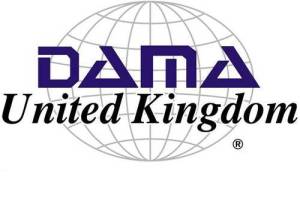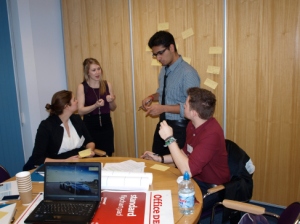
Please let me introduce myself once again: I’m Merel van Dijke, member of DAMA UK. Last Wednesday (2nd of April) I had the pleasure to go to my first DAMA conference ever, about a subject I desperately wanted to know more about: Data Management in the Cloud. Waking up at 5AM was no treat, but luckily the bus, train and car ride to Essex all went smoothly, and in good company J. It was great meeting so many professionals in our field, and to get out of the box called the university. Seeing how the theory actually works in practice was eye opening and really informative! Therefore I want to share my 11 biggest learning points of the day with you!
#1 IT is becoming like water: Only pay when you use (Nigel Turner)
Nigel opened the day with a quick overview of the cloud. Computing becomes more and more like a service, enabling us to share our resources over a network. Clouds are as customizable as can be, allowing for public, private and even hybrid form. After IaaS, PaaS, SaaS and more, it’s now all about XaaS. Which basically means: everything you could possibly want in a cloud.
#2 Clouds are not just awesome. There are cons. (Nigel Turner)
Although clouds allow for greater speed, adoption, standardisation, performance, security and flexibility, don’t say Hallelujah just yet. They also have parts that aren’t that great. After all, you’re trusting your data with someone else, not knowing where it exactly is (and under which law they fall). And in this immature market, the chances of getting stuck with your vendor are high, while clouds are hard to integrate!
#3 Governance is becoming even more important (Nigel Turner)
The cloud is a paradigm shift, since basically everything is getting outsourced. The only thing you really can’t outsource though, is data governance. The data architecture and quality have to be maintained at all times. There lies the future for data professionals.
#4 Don’t put everything in the cloud (Kawser Hamid)
Always keep the Data Protection Act in mind when you’re putting your data in the cloud. Since something is done with personal data (held/processed), it is not without risk. Who are the controllers and processors are of your data? And is it handled under EU or US law? Is the data being held safely? All important questions to keep in mind!
#5 It should not be managed by only 1 department (Kawser Hamid)
The cloud is super cooperative and should therefore not be managed by IT alone. HR, for example, has an equally important role in the process.
#6 Laws are changing. Keep an eye on them! (Scott Sammons)
National, as well as European and international laws are constantly changing, along with definitions of concepts as privacy and transparency. The next big thing will/might be one rule for all countries in Europe, which may seem more simple, but actually makes things complex. Also, clouds make it harder to detect breaches. At the moment, breaches have to be found in 72 hours, but with clouds that’s just impossible.
#7 The right to be forgotten is weird (Interp of Scott Sammons)
You have the right to be forgotten, but that also means that the company will forget that you don’t want to be contacted anymore. Since that is forgotten. So you can never really get rid of companies – they either contact you or store some of your personal data so they don’t contact you in the future. Weird stuff.
#8 Good decisions require good data. (Chris Hubbard)
Master Data Management (MDM) can also be done in the cloud. When did who do what with my data? Questions that need answering to keep the consistency, quality, permissions and rules surrounding that data in an optimal state.
#9 The IT Paradox (Chris Hubbard)
While CPU, memory and storage costs go down, regulations, competition, innovation and IT costs go up! Staying ahead of the competition can be done by putting MDM in a cloud for lower costs and time, but higher innovation. On the plus side, you can build stronger ROI cases and reduce ownership costs. But at the same time you should always consider whether clouds can hold for example big data, and if the data is sensitive.
#10 The Cloud is not new, but has a major impact (Neil Harvey)
The Cloud is basically a ‘new’ kind of outsourcing that has been around for quite some years (think of Gmail). It impacts both the profession of data management as a whole, but also the professional him/herself. IT departments will become smaller, while more softer skills are needed.
#11 Bad data can be just as helpful as good data (Neil Harvey)
Bad data are a sign of broken processes. Fixing these processes will not only improve the data but also the entire company as a whole.
As you can see: A very interesting day with some great speakers to learn from. I left the room feeling enlightened, and with a more holistic view of the subject than I had before. The day also taught me one last thing: the skills I learn in my MSc Knowledge and Information Systems Management is becoming more and more important in the future. Linking technology to the business, while focusing on governance, multicultural collaboration, social media and integration are the key points we constantly get taught about in lectures. Seeing that it is actually important makes me feel even more happy with my degree.
Thank you DAMA UK for opening my eyes and showing me all the pros and cons of cloud computing. I can’t wait for the next meeting in June!



